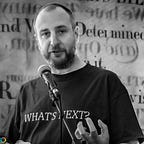Why a target operating model is killing your public service
Time for a transformation?
There’s a healthy industry out there in transforming organisations. Every consultancy has a slightly different take. Even so there is a broad consensus on the right approach.
You look at the challenges facing your organisation right now (austerity, digital, high fixed costs). Then you design a new way of doing things that will be better (cheaper, more online, even cheaper). Then you transform the organisation from where it is now to this new, improved state you’ve imagined.
That new improved state is your target operating model. With a target operating model change becomes easy. Everyone knows where you are aiming so they can plan their part in the transformation. You can price the changes, estimate the savings and so make a business case. Accountants are happy, ICT and HR and property folk relax.
There’s just one problem.
Actually there are two.
There are just two problems.
Problem one. You do not know what the target is.
Let us consider the world of public services. Fraught with complexity at the best of times, managers must now work out how to patch and mend vital services to address spiralling demand and plummeting revenue.
No-one knows how to design good public services in this looking glass world.
We can guess at some broad directions of travel but we need to design new approaches to services.
The target operating model you draw up now will be a poor fit for the real needs of service users. This is partly because the context is shifting so fast that your model will be out of date long before you get there. It’s also because you are human. The target operating model you decide to work with will be quite like what you have now with modifications. The same but cheaper, or more online, or outsourced.
To design something from first principles, based in meeting the real needs of the service users will take time. And an acceptance that you do not know what the target is. We have an approach to help with this. It is Agile. As Matt Edgar has written “agile transformation isn’t a one-off thing that you do to get from A to B — it’s a continuous culture of iterative improvement”.
Problem two. Thinking like a Victorian.
The public services we have in the UK would be instantly recognisable to a Victorian bureaucrat. They might be a little startled by the open plan offices (and the mobile phones) but the basic operating model of hierarchy, decisions, information passing up and down the management chain, and of senior figures operating the levers of power haven’t changed in hundreds of years.
We think of organisations as machines. We think of humans as cogs. We see senior managers as engineers making adjustments, opening valves and throttling flows to get the right output. This was probably never a useful way to think about organisations which are, after all, made up of human beings but for organisations trying to deliver services in the connected age it is positively destructive.
The very idea of the target operating model is machine-thinking. The operating environment has changed. It comes from people who think we need to dismantle the steam engine and put it back together so it’s a bit smaller and a bit faster.
But even if you could dismantle and rebuild your steam engine in such a way that it would meet the needs of service users now, those needs and the operating context will change again. Rapidly and unpredictably.
Don’t transform. Adapt.
Public services in the connected age need to be able to adapt and change without the rigmarole, overhead and delay of transformation programmes.
We need to start thinking of them as networks of human beings not towers of cogs and switches.
We need to kill off target operating models.
